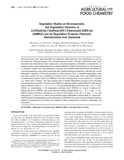| dc.description.abstract | Degradation Studies on Benzoxazinoids. Soil Degradation Dynamics of 2,4-Dihydroxy-7-methoxy-(2 H)-1,4-benzoxazin-3(4 H)-one (DIMBOA) and Its Degradation Products, Phytotoxic Allelochemicals from Gramineae
(Macías, Francisco A.; Oliveros, Alberto; Marín, David; Castellano, Diego; Simonet, Ana M. and Molinillo G., José M.)
Abstract
Benzoxazinoids have been described as important allelochemicals from Gramineae as well as Acanthaceae, Rannunculaceae, and Scrophulariaceae plants. Several bioactivities have been described and evaluated for these compounds, including fungistatic, antifeedant, and phytotoxic. In ongoing studies about allelochemicals as natural herbicide models, the description of soil dynamics in phytotoxic agents has high importance, because the possible biotransformations developed by soil microorganisms could yield compounds with modified biological properties, affecting the overall allelopathic capability of the producer plant in a direct manner. Thus, a complete degradation study has been carried out for 2,4-dihydroxy-7-methoxy-(2 H)-1,4-benzoxazin-3(4 H)-one (DIMBOA) and 6-methoxybenzoxazolin-2 (3 H)-one (MBOA) in two soils cultivated with Triticum aestivumL. Varieties (cv. Astron and cv. Ritmo). The main purpose was to identify degradation products and to elucidate biotransformation dynamics. Results show DIMBOA to degrade rapidly, yielding MBOA in both studied soils at different doses ( t1/2 ) 31 ( 1 h, n) 12) and reaching high conversions (80 ( 4 h, n) 42). MBOA, an intermediate in the degradation pathway from DIMBOA to 2-amino-7-methoxy-3 Hphenoxazin-3-one (AMPO), was more resistant toward biodegradation ( t1/2 ) 5 ( 1 days, n) 6). MBOA showed maximum conversions at a dose of 250 mg/kg of soil (36 ( 3 days, n ) 6). Soil belonging to T. aestivum cv. Ritmo crops showed higher degradation capacity than cv. Astron soil. AMPO was the final degradation product observed for DIMBOA in the soils and experimental conditions selected. Consequences for activity and stability of these compounds in relation to allelopathy are discussed.
© 2004 American Chemical Society
Published on: Journal of Agricultural and Food Chemistry 2004, 52, 6402-6413. | es_VE |


